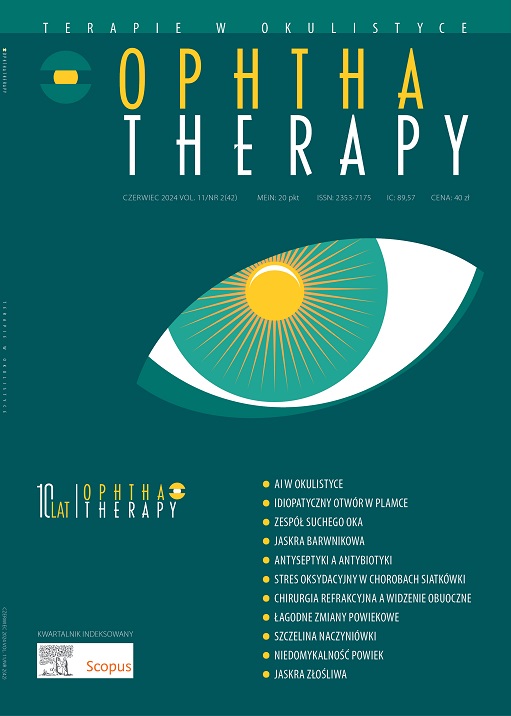Levator palpebrae superioris lengthening in the treatment of keratopathy caused by lagophthalmos after orbital inflammation Case report
Main Article Content
Abstract
This study aims to evaluate the efficacy of various management strategies for lagophthalmos in a 56-year-old female patient, with a focus on both non-surgical and surgical interventions. The patient underwent an array of non-surgical treatments, including artificial tears, ointments, and therapeutic contact lenses, aimed at maintaining ocular surface integrity. For surgical intervention, the study compared the outcomes of gold weight implantation (GWI), platinum weight implants, modified tarsorrhaphy (MT), and the elongation of the aponeurosis levator superioris muscle. Non-surgical management provided symptomatic relief and temporary protection of the corneal surface. Botulinum toxin A injection may result in improved eyelid closure without significant adverse effects. Surgically, GWI and platinum implants effectively reduced corneal exposure, though the latter presented fewer complications. MT proved advantageous in terms of accessibility and cost. The elongation technique showed improved aesthetic and functional outcomes, as evidenced by patient satisfaction scores.
Downloads
Article Details

This work is licensed under a Creative Commons Attribution-NonCommercial-NoDerivatives 4.0 International License.
Copyright: © Medical Education sp. z o.o. License allowing third parties to copy and redistribute the material in any medium or format and to remix, transform, and build upon the material, provided the original work is properly cited and states its license.
Address reprint requests to: Medical Education, Marcin Kuźma (marcin.kuzma@mededu.pl)
References
2. Stern ME, Schaumburg CS, Pflugfelder SC. Dry eye as a mucosal autoimmune disease. Int Rev Immunol. 2013; 32: 19-41.
3. Stevenson W, Chauhan SK, Dana R. Dry eye disease: an immune- mediated ocular surface disorder. Arch Ophthalmol. 2012; 130: 90-100.
4. Li M, Gong L, Chapin WJ, Zhu M. Assessment of vision-related quality of life in dry eye patients. Invest Ophthalmol Vis Sci. 2012; 53: 5722-7.
5. Schiffman RM, Walt JG, Jacobsen G et al. Utility assessment among patients with dry eye disease. Ophthalmology. 2003; 110(7): 1412-9.
6. Sall K, Stevenson OD, Mundorf TK et al. Two multicenter, randomized studies of the efficacy and safety of cyclosporine ophthalmic emulsion in moderate to severe dry eye disease. CsA Phase 3 Study Group. Ophthalmology. 2000; 107: 631-9.
7. Lawrence S, Morris C. Lagophthalmos Evaluation and Treatment. EyeNet. 2008.
8. Swiston CJ, Hu KS, Simpson A et al. Prevention of Exposure Keratopathy in the Intensive Care Unit: Evaluation of an EMR-Based Lubrication Order Protocol for Ventilated Patients. J Acad Ophthalmol (2017). 2022; 14(2): e141-e146. http://doi.org/10.1055/s-0042-1750020.
9. Lai CC, Lin CC. Case Report: Botulinum Toxin-A for Complication of Exposure Keratopathy Following Frontalis-Orbicularis Oculi Muscle Flap Shortening. Front Med. 2022; 9: 877162. http://doi.org/10.3389/fmed.2022.877162.
10. Nowak-Gospodarowicz I, Różycki R, Rękas M. Quality of Life in Patients with Unresolved Facial Nerve Palsy and Exposure Keratopathy Treated by Upper Eyelid Gold Weight Loading. Clin Ophthalmol. 2020; 14: 2211-22. http://doi.org/10.2147/OPTH.S254533.
11. Gerstenblith AT, Rabinowitz MP. The Wills eye manual :office and emergency room diagnosis and treatment of eye disease. 6th ed. Wolters Kluwer/Lippincott Williams & Wilkins, 2012.
12. Shaheen BS, Bakir M, Jain S. Corneal nerves in health and disease. Surv Ophthalmol. 2014; 59: 263-85. http://doi.org/10.1016/j.survophthal.2013.09.002.
13. Ezra DG, Lewis G, Healy M et al. Preventing exposure keratopathy in the critically ill: A prospective study comparing eye care regimes. Br J Ophthalmol 2005; 89: 1068-9.
14. Kasparova EA, Sobkova OI, Kasparova EA et al. [Surgical treatment of purulent corneal ulcers in eyes with neurotrophic keratitis and paralytic lagophthalmos]. Vestn Oftalmol. 2017; 133(5): 32-37. http://doi.org/10.17116/oftalma2017133532-37.
15. Laihia J, Kaarniranta K. Trehalose for Ocular Surface Health. Biomolecules. 2020; 10(5): 809. http://doi.org/10.3390/biom10050809.
16. Chandler JR, Langenbrunner DJ, Stevens ER. The pathogenesis of orbital complications in acute sinusitis. Laryngoscope. 1970; 80: 1414-28.
17. Chaudhry IA, Al-Rashed W, Arat YO. The hot orbit: Orbital cellulitis. Middle East Afr J Ophthalmol. 2012; 19: 34-42.
18. Pandian DG, Babu RK, Chaitra A et al. Nine years-review on preseptal and orbital cellulitis and emergence of community-acquired methicillin-resistant Staphylococcus aureus in a tertiary hospital in India. Indian J Ophthalmol. 2011; 59: 431-5.
19. Israele V, Nelson JD. Periorbital and orbital cellulitis. Pediatr Infect Dis J. 1987; 6: 404-10.
20. Şahin MM, Uzunoglu E, Karamert R et al. The role of gold weight implants in the management of paralytic lagophthalmos. Turk J Med Sci. 2021; 51(5): 2584-91. http://doi.org/10.3906/sag-2104-50.
21. Sharon JD, Kraus CL, Ehrenburg M et al. Risk Assessment and Prevention of Corneal Complications After Lateral Skull Base Surgery. Otol Neurotol. 2016; 37(8): 1148-54. http://doi.org/10.1097/MAO.0000000000001123.
22. Matsuo T, Tsuchida Y, Morimoto N. Trehalose eye drops in the treatment of dry eye syndrome. Ophthalmology. 2002; 109(11): 2024-9. http://doi.org/10.1016/s0161-6420(02)01219-8.
23. Vanaporn M, Titball RW. Trehalose and bacterial virulence. Virulence. 2020; 11(1): 1192-202. http://doi.org/10.1080/21505594.2020.1809326.
24. Pinto-Bonilla JC, Del Olmo-Jimeno A, Llovet-Osuna F et al. A randomized crossover study comparing trehalose/hyaluronate eyedrops and standard treatment: patient satisfaction in the treatment of dry eye syndrome. Ther Clin Risk Manag. 2015; 11: 595-603. http://doi.org/10.2147/TCRM.S77091.
25. Tint NL, Saxby EPI, Young SL et al. A modified transconjunctival technique for botulinum toxin chemodenervation of levator palpebrae superioris for corneal protection. Eye (Lond). 2022; 36(6): 1217-21. http://doi.org/10.1038/s41433-021-01587-x.
26. Kirkness CM, Adams GG, Dilly PN et al. Botulinum toxin A-induced protective ptosis in corneal disease. Ophthalmology. 1988; 95(4): 473-80. http://doi.org/10.1016/s0161-6420(88)33163-5.
27. Berghaus A, Neumann K, Schrom T. The platinum chain: a new upper-lid implant for facial palsy. Arch Facial Plast Surg. 2003; 5(2): 166-70. http://doi.org/10.1001/archfaci.5.2.166.
28. Vásquez LM, Medel R. Lagophthalmos after facial palsy: current therapeutic options. Ophthalmic Res. 2014; 52(4): 165-9. http://doi.org/10.1159/000365519.
29. Irawati Y, Natalia MER, Gondhowiardjo TD et al. Modified tarsorrhaphy versus gold weight implant technique for paralytic lagophthalmos treatment in patients with leprosy: One-year observation of a randomized controlled trial study. Front Med (Lausanne). 2023; 9: 941082. http://doi.org/10.3389/fmed.2022.941082.
30. Guillou-Jamard MR, Labbé D, Bardot J et al. Paul Tessier's technique in the treatment of paralytic lagophthalmos by lengthening of the levator muscle: evaluation of 29 cases. Ann Plast Surg. 2011; 67(6): S31-5. http://doi.org/10.1097/SAP.0b013e318218360b.
31. Krastinova-Lolov D. Chirurgie Palliative Des Sequelles De Paralysie Faciale Peripherique. Communication SOC FCPRE, Paris 1989.

